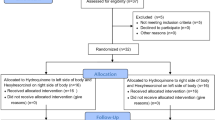Abstract
▴ Eflornithine is a specific, irreversible inhibitor of the enzyme ornithine decarboxylase which is thought to slow hair growth by inhibiting this enzyme in hair follicles.
▴ Percutaneous absorption of eflornithine in women with unwanted facial hair (hirsutism) was <1% when the 15% cream was applied twice daily to a shaved 50cm2 area of skin under the chin. ▴ In clinical studies in women with excessive, unwanted facial hair, eflornithine 15% cream was superior to placebo in reducing hair growth, as demonstrated by objective and subjective methods, after 2 to 8 weeks’ treatment.
▴ After 24 weeks’ treatment, 58% of eflornithine and 34% of placebo recipients had at least some improvement in facial hirsutism (for the purposes of this analysis all patients not assessed at week 24 were considered to be worse or to have no improvement). In addition, 32 versus 8% of patients were judged to be successfully treated (at least marked improvement). Hair growth returned to pretreatment rates within 8 weeks of stopping treatment.
▴ Use of a self-assessment questionnaire to assess the effect of study treatment on 6 aspects of patient well-being showed that eflornithine reduced the mean level of overall discomfort and bother by 33 versus 15% in placebo recipients.
▴ Adverse events mostly affected the skin. Only burning/stinging/ tingling was markedly more common with eflornithine than with placebo.



Similar content being viewed by others
References
Rittmaster R.S. Hirsutism. Lancet 1997 Jan 18; 349: 191–195
Conn J.J., Jacobs H.S. Managing hirsutism in gynaecological practice. Br J Obstet Gynaecol 1998 Jul; 105: 687–696
Falsetti L., Gambera A., Platto C., et al. Management of hirsutism. Am J Clin Dermatol 2000; 1: 89–99
Conn J.J., Jacobs H.S. The clinical management of hirsutism. Eur J Endocrinol 1997 Apr; 136: 339–348
Mosby’s GenRx. Update 3, 2000 ed. Available from: URL:http/www.mosbysgenrx.com [Accessed 2000 Oct 24]
Bristol-Myers Squibb Eflornithine prescribing information. Princeton (NJ): 2000 Jul
Shander D., Funkhouser M.G., Ahluwalia G.S., et al. Pharmacology of hair growth inhibition by topical treatment with eflornithine-HCl monohydrate (DFMO) using the hamster flank organ model [abstract no. 123]. American Academy of Dermatology 59th Annual Meeting; 2001 Mar 2–7; Washington, DC
Shander D., Funkhouser M.G., Harrington F.E., et al. Clinical dose range studies with topical application of the ornithine decarboxylase inhibitor eflornithine HCl ((alpha-(difluoromethyl)-DL-ornithine; DFMO) in women with facial hirsutism [abstract no. 228]. American Academy of Dermatology 59th Annual Meeting; 2001 Mar 2–7; Washington, DC
Malhotra B., Palmisano M., Schrode K., et al. Percutaneous absorption, pharmacokinetics and dermal safety of eflornithine 15% cream in hirsute women [poster]. American Academy of Dermatology 58th Annual Meeting; 2000 Mar 10–15; San Francisco
Huber F., Schrode K., Staszak J., et al. Use of a video imaging system to obtain hair measurement data in controlled clinical trials evaluating the safety and efficacy of eflornithine 15% cream in the treatment of excessive facial hair in women [poster]. American Academy of Dermatolgy 58th Annual Meeting; 2000 Mar 10–15; San Francisco
Schrode K., Huber F., Staszak J., et al. Randomized, double-blind, vehicle-controlled safety and efficacy evaluation of eflornithine 15% cream in the treatment of women with excessive facial hair [poster]. American Academy of Dermatology 58th Annual Meeting; 2000 Mar 10–15, San Francisco
Schrode K., Huber F., Staszak J., et al. Evaluation of the long-term safety of eflornithine 15% cream in the treatment of women with excessive facial hair [poster]. American Academy of Dermatology 58th Annual Meeting; 2000 Mar 10–15; San Francisco
Huber F., Schrode K., Staszak J., et al. Outcome of a qulaity of life assessment used in clinical trials for hirsute women treated with topical eflornithine cream [poster]. American Academy of Dermatology 58th Annual Meeting; 2000 Mar 10–15; San Francisco
Data on file, Bristol-Myers Squibb, 2000 Nov.
Author information
Authors and Affiliations
Corresponding author
Rights and permissions
About this article
Cite this article
Balfour, J.A.B., McClellan, K. Topical Eflornithine. Am J Clin Dermatol 2, 197–201 (2001). https://doi.org/10.2165/00128071-200102030-00009
Published:
Issue Date:
DOI: https://doi.org/10.2165/00128071-200102030-00009




